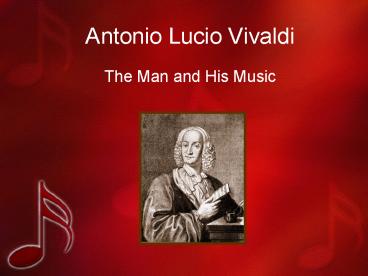Antonio Lucio Vivaldi - PowerPoint PPT Presentation
1 / 18
Title:
Antonio Lucio Vivaldi
Description:
Antonio Vivaldi was born in Venice in 1678, the son of a barber ... such schools in Venice. ... The Church of Vivaldi in Venice. S. Maria della Piet ... – PowerPoint PPT presentation
Number of Views:421
Avg rating:3.0/5.0
Title: Antonio Lucio Vivaldi
1
Antonio Lucio Vivaldi
- The Man and His Music
2
VIVALDI THE PRIEST Antonio Vivaldi was born in
Venice in 1678, the son of a barber who was also
a violinist in the orchestra of St. Mark's
Cathedral. His health was poor throughout his
life and he suffered from a chronic illness which
has been interpreted either as a heart condition
or a form of asthma.
Vivaldi was also known as The Red Priest
because of the red cloak he often wore.
3
His father entered him into the long training for
the priesthood at the age of 14. He was ordained
in 1703 when he was 25 years old. One of his
duties was to sing Mass. This meant that he had
to sing and chant for nearly an hour at a time.
Vivaldi found this difficult as he had a weak
chest. Thus, after a year, he gave up singing
Mass altogether. Vivaldi was known as the "Red
Priest" because of his red hair (inherited from
his father.) He became a priest before he became
a composer, but his heart, mind, and soul were
completely devoted to music.
4
He became the music teacher at an all girls
orphanage called the Ospedale delle Pieta (the
Hospital of Pity or compassion.) There were four
such schools in Venice. It was his job to teach
the young girls to play music and write two
concertos every month for them to perform. This
accounts for the variety of instruments Vivaldi
wrote for, since he had to showcase each of the
young girl's talents.
5
(No Transcript)
6
The Pietà in Vivaldi's day! The Pietà was one of
four Venetian ospedali, each with a different
function the Mendicanti housed the poor, the
homeless, beggars, war wounded etc. the
Ospedaletto was a home for orphans the
Incurabili housed those with incurable diseases
the Pietà was a home for abandoned and unwanted
babies, not (as is often stated) a convent or a
school for girls.
Babies were brought in for various reasons, some
found by the roadside or floating in the canals,
perhaps from families too poor to bring them up,
or whose mothers had no milk. They were placed in
foster homes for the first six years, and then
returned to the Pietà. The boys learned a trade
such as stone cutting, weaving or shoe making,
and left equipped with a skill at the age of 16.
The girls had three options to marry, to become
nuns, or to stay at the Pietà for the rest of
their lives. There were two groups, the Figlie di
Comun (nonmusicians), who did the sewing,
embroidery, silk and cotton weaving, took care of
various tasks in the institution and sold some of
the work they produced, and the Figlie di Choro
(musicians), the élite of the Pietà, some 6070
in Vivaldis day, who had separate rooms and a
special diet.
7
(No Transcript)
8
A privileged few were allowed to earn extra
income by teaching the daughters of wealthy
families sent to the Pietà as Figlie in
Educazione. The two senior musicians were known
as maestra, and the head of the household was the
priora. The skills of the "choro" attracted
visitors from across Europe and a visit to the
Pietà became a feature of the Grand Tour.
La Chiesa di Vivaldi - The Church of Vivaldi in
Venice. S. Maria della Pietà
9
Vivaldis job was to train those girls who showed
musical promise (about one in ten) to sing and
play instruments during services at La Pietà. He
wrote many works for this establishment, and
evidence suggests that all the vocal parts were
sung by women, including tenor and bass. He
started his career at the Pietà as Maestro di
Violin in September 1703, aged 25, six months
after being ordained a priest. In 1714 he was
invited to succeed Francesco Gasparini as Maestro
di Choro, but refused the post a short time
later, however, he was appointed to the specially
created office of Maestro dei Concerti. During
this period he wrote his first sacred works,
including the wellknown Gloria.
10
The Four Seasons
11
(No Transcript)
12
(No Transcript)
13
(No Transcript)
14
(No Transcript)
15
The Operas of Vivaldi
16
Vivaldi is one of the best-known Baroque
composers thanks to his instrumental concertos.
In his time, however, he was very successful as
an opera composer and entrepreneur. Later his
operatic output was neglected, but in recent
years audiences around the world have had a
chance to become acquainted with his
musical-dramatic works. In
Antonio Vivaldi Orlando Furioso
17
Motezuma's Revenge - A Long-Lost Vivaldi Opera
Antonio Vivaldi returned to his hometown of
Venice early in 1733, eager to reclaim his place
as the Venetian republic's most popular composer.
During his five-year absence, younger
Naples-trained musicians had come to the fore
with their own "dramas with music," but now, at
55, Vivaldi was ready to take them on with a
daringly modern opera inspired by Hernando
Cortés's conquest of the Aztecs. How the work,
Motezuma, was received at its premiere at the
Teatro di Sant'Angelo in Venice in the fall of
1733 is not known. But it can be assumed that it
did not revive Vivaldi's fortunes. He wrote at
least two more operas in Venice before moving to
Vienna in March 1740 to seek the patronage of the
Hapsburg Empire. And it was there, reportedly in
a state of penury, that he died on July 28, 1741.
18
Links
- http//www.montgomeryschoolsmd.org/schools/takomap
arkms/academics/cs/grade8projects/learnaboutmusic/
index.html - http//www.classicsforkids.com/shows/showview.asp?
ID1 - http//www.classical.net/
- http//www.geocities.com/music_ajtt/index.html































